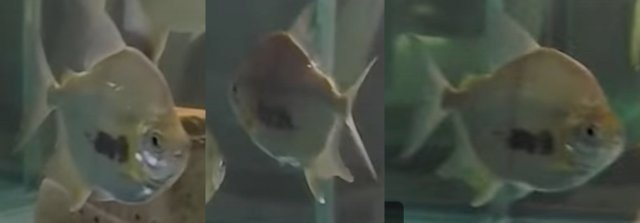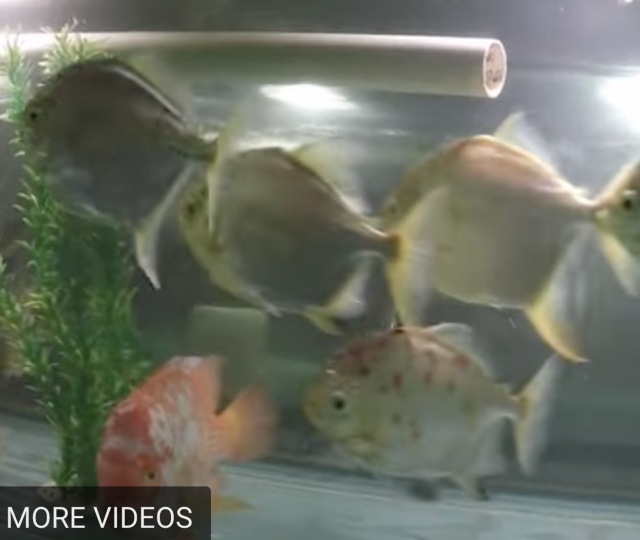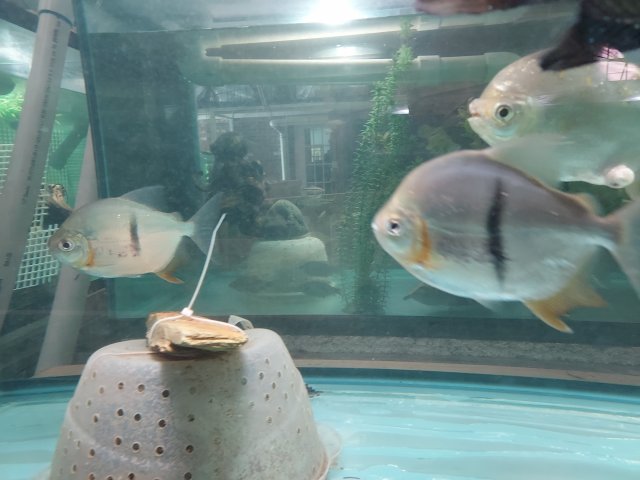Silver dollars at Fish Story Aquarium and Rescue
- Thread starter thebiggerthebetter
- Start date
You are using an out of date browser. It may not display this or other websites correctly.
You should upgrade or use an alternative browser.
You should upgrade or use an alternative browser.
Beautiful fish in nice big tank....
I hope you can tell me about this individual fish (2?) in your last video (photos below); actually I think there are two identical ones. Although I cant really see it well, it seems to have a smallish adipose fin, but longer than the adipose fin in all other dollars in the tank. Long adipose fin defines Metynnis spp., whereas short adipose fin defines Myleus-Myloplus (and other genera). This fish appears to have a longish (ish, meaning somewhat intermediate, but that probably is because I am not seeing clearly enough).
It is a full grown male. However, it is not a thin bar, nor a wide black bar, nor a red-hook. Despite being fully developed, it is substantially smaller than the other Myleus in the tank, and the other of the same kind, is about the same size.
What name do you use to refer to them? It appears to me you call them Thin bars? Is that the name given to you when you acquired the fish? They do no seem to be that species (both thin and wide bars are currently referred to as "Myleus schomborgkii", although there is clarity among the experts that 2-3 good species are involved in the current mess). They may be thin bars, but they appear non-typical and somewhat different. Regardless, thin bars do stay substantially smaller than both wide-bars, and red-hooks.
If I were to take a guess, it seems somewhat similar (but different) to the "Strawberry Myleus dollars", which are hybrids (supposedly of two Myleus spp.), but I am not certain of what taxa. In your fish, the black color patch is different in shape and position, and there are no red fins as typical in strawberries. On the other hand, the smaller size is consistent with being related to those fish.
Any info? Would you be able to snap a couple of nice, flat (side) pictures of those fish? Cell phone quality would be perfect. That could settle their identity. Many thanks in advance, and Cheers!!!

Regarding genders, let's make sure we are calling things the same:
In the photo below (also from the video), there are 4 SD's seen complete - top left a female, at center a male, at right a female, and at the bottom another male next to the cichlid.
The larger, longer hooks are females; the bi-lobed, shorter hooks are males. Red-spotting does indicate maturity/hierarchy/dominance (but not always), and can be shown by both males and females.

Beautiful fish. Thanks for sharing!!!!
I hope you can tell me about this individual fish (2?) in your last video (photos below); actually I think there are two identical ones. Although I cant really see it well, it seems to have a smallish adipose fin, but longer than the adipose fin in all other dollars in the tank. Long adipose fin defines Metynnis spp., whereas short adipose fin defines Myleus-Myloplus (and other genera). This fish appears to have a longish (ish, meaning somewhat intermediate, but that probably is because I am not seeing clearly enough).
It is a full grown male. However, it is not a thin bar, nor a wide black bar, nor a red-hook. Despite being fully developed, it is substantially smaller than the other Myleus in the tank, and the other of the same kind, is about the same size.
What name do you use to refer to them? It appears to me you call them Thin bars? Is that the name given to you when you acquired the fish? They do no seem to be that species (both thin and wide bars are currently referred to as "Myleus schomborgkii", although there is clarity among the experts that 2-3 good species are involved in the current mess). They may be thin bars, but they appear non-typical and somewhat different. Regardless, thin bars do stay substantially smaller than both wide-bars, and red-hooks.
If I were to take a guess, it seems somewhat similar (but different) to the "Strawberry Myleus dollars", which are hybrids (supposedly of two Myleus spp.), but I am not certain of what taxa. In your fish, the black color patch is different in shape and position, and there are no red fins as typical in strawberries. On the other hand, the smaller size is consistent with being related to those fish.
Any info? Would you be able to snap a couple of nice, flat (side) pictures of those fish? Cell phone quality would be perfect. That could settle their identity. Many thanks in advance, and Cheers!!!

Regarding genders, let's make sure we are calling things the same:
In the photo below (also from the video), there are 4 SD's seen complete - top left a female, at center a male, at right a female, and at the bottom another male next to the cichlid.
The larger, longer hooks are females; the bi-lobed, shorter hooks are males. Red-spotting does indicate maturity/hierarchy/dominance (but not always), and can be shown by both males and females.

Beautiful fish. Thanks for sharing!!!!
No problem. Thanks!
Amazing tank and fish.
I am glad of no more deaths among the Hemiodus. Still a mystery!
Amazing tank and fish.
I am glad of no more deaths among the Hemiodus. Still a mystery!
Thank you for the continued sharing of your knowledge, greatly appreciated!
You're right, I got males and females mixed up, great catch, thank you. I am so used to the anal fin being pointier in many cyprinids, I guess, that I projected it on the SDs too.
The 3 smaller, rescued / donated SDs (from Aug 2022, 2 males 1 female) you had asked about in Feb 2023 grew some since then and the black rough (looks like many small cuts / ridges?) spots changed the appearance a bit too, not so dark anymore. TBH I thought they were injuries, but you seem to say that these are the norm. Only the 2 males have them, the 1 female doesn't. I am attaching photos for you below, hopefully they'll help, feel free to ask for more photos or videos, I love learning from you. I don't recall if the donor had said what they were, I think I started calling them thin bars for the lack of more than superficial familiarity with the SD species.





You're right, I got males and females mixed up, great catch, thank you. I am so used to the anal fin being pointier in many cyprinids, I guess, that I projected it on the SDs too.
The 3 smaller, rescued / donated SDs (from Aug 2022, 2 males 1 female) you had asked about in Feb 2023 grew some since then and the black rough (looks like many small cuts / ridges?) spots changed the appearance a bit too, not so dark anymore. TBH I thought they were injuries, but you seem to say that these are the norm. Only the 2 males have them, the 1 female doesn't. I am attaching photos for you below, hopefully they'll help, feel free to ask for more photos or videos, I love learning from you. I don't recall if the donor had said what they were, I think I started calling them thin bars for the lack of more than superficial familiarity with the SD species.





Interesting and maybe useful exchange on YT:
rajiv9819 Beautiful Dollar fishes. I just like this species. They regularly spawn in community tank too!
Fish-Story Really?? I've never see ours show any kind of courtship, let alone spawning behavior.
rajiv9819 Yes. I think soft and cooler water temp around 25C and siphoning 50 to 60 percent water can induce favorable conditions.
rajiv9819 Beautiful Dollar fishes. I just like this species. They regularly spawn in community tank too!
Fish-Story Really?? I've never see ours show any kind of courtship, let alone spawning behavior.
rajiv9819 Yes. I think soft and cooler water temp around 25C and siphoning 50 to 60 percent water can induce favorable conditions.
The red hook that had for years a ball-like swelling / tumor on the tummy area has suddenly passed. 10 yo 9 inches.
Ik this is old and someone might have answered but silver dollars are fin nippersThe second of the pair of common SDs has perished. About 7" tip to tip. I have not been paying it much attention and then saw one day that most of its tail fin was missing. Even though it still fed and behaved ok, I rehomed it to another 240 gal but it died there shortly thereafter... I am guessing from the additional stress of the netting and transferring.
I wonder who was biting its tail so badly. Could have red hooks and wide bars done it? Or the relatively newly introduced rescue clown knife? I've caught it giving a quick chase to a SD every now and then.
View attachment 1366206


